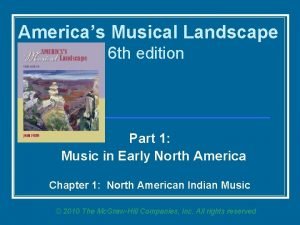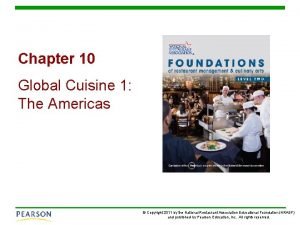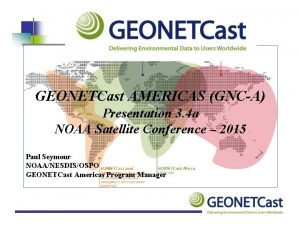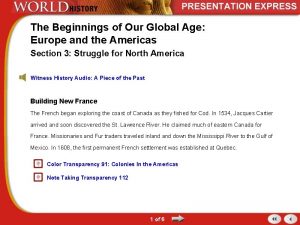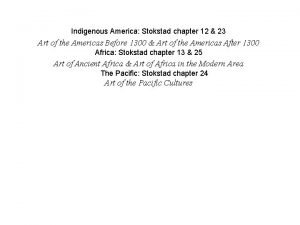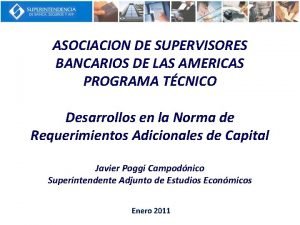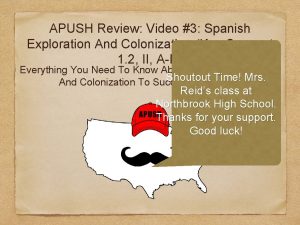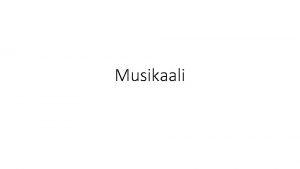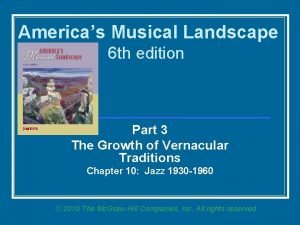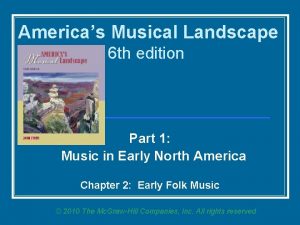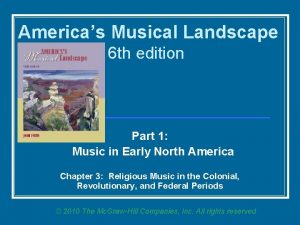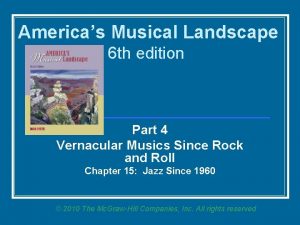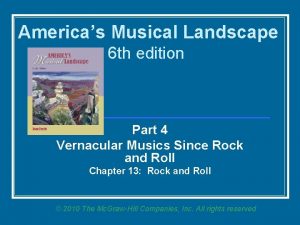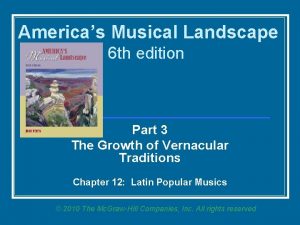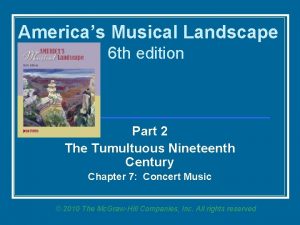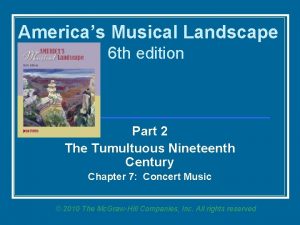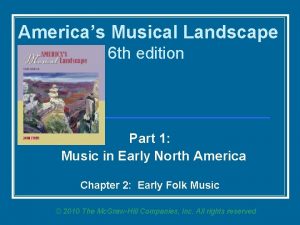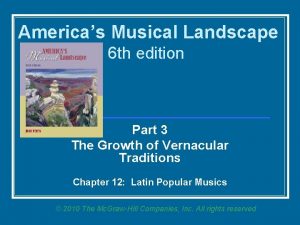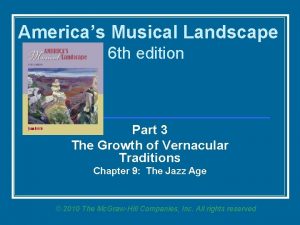Americas Musical Landscape 6 th edition Part 5














- Slides: 14

America’s Musical Landscape 6 th edition Part 5 Music for Theater and Film Chapter 18: Music for Films © 2010 The Mc. Graw-Hill Companies, Inc. All rights reserved

Functions of Music in Film Score – the music composed for a movie n Mickey Mousing – the practice of mimicking musically the actions of a character n Music draws the audience into the atmosphere of the film n Music helps build a sense of continuity n © 2010 by The Mc. Graw-Hill Companies, Inc. All rights reserved. Part 5: Music for Theater and Film Chapter 18: Music for Films 2

Source Versus Functional Music n Source/Diegetic Music – provides a thematic anchor for images on screen n Music adds accompaniment to the action in films featuring dance n Fame (1980) n Saturday Night Fever (1977) n Functional/Nondiegetic Music – the music is heard by the spectators, but not by the characters in the film © 2010 by The Mc. Graw-Hill Companies, Inc. All rights reserved. Part 5: Music for Theater and Film Chapter 18: Music for Films 3

History of Music in Films n Silent Films – music was provided by pianists, theater organists, and other instrumentalists n Early Sound Films – The Jazz Singer n Most composers working in early Hollywood were European with the exception of several notable American composers n Virgil Thompson n Aaron Copland n Irving Berlin © 2010 by The Mc. Graw-Hill Companies, Inc. All rights reserved. Part 5: Music for Theater and Film Chapter 18: Music for Films 4

Bernard Herrmann (1911 -1975) n n n A New Yorker who carried his classical music training to radio, where he worked as a composer and arranger, and then to film Scored Orson Welles’ Citizen Kane (1941) Best-known for his work scoring films by Alfred Hitchcock © 2010 by The Mc. Graw-Hill Companies, Inc. All rights reserved. Part 5: Music for Theater and Film Chapter 18: Music for Films 5

Listening Example 63 This disturbingly effective music supports one of the most terrifying scenes in movie history. The Murder (from Psycho) Composed by Bernard Hermann (1911 -1975) Listening Guide page 324 Timbre: Orchestra, dominated by high-pitched strings as the players glide their fingers rapidly along the strings (a technique called glissando) Form: Programmatic (the music describes and enhances the actions on the screen) Melody: Fragmentary phrases, repeated over and over © 2010 by The Mc. Graw-Hill Companies, Inc. All rights reserved. Part 5: Music for Theater and Film Chapter 18: Music for Films 6

The Hollywood Sound n Key figures in Hollywood music from the 1930 s and 1940 s n n Alfred Newnan Max Steiner Erik Korngold John Williams – popularized the classic film score in movies such as Jaws, Star Wars, Raiders of the Lost Ark © 2010 by The Mc. Graw-Hill Companies, Inc. All rights reserved. Part 5: Music for Theater and Film Chapter 18: Music for Films 7

Listening Example 64 This highly emotional film score helped return the lush, romantic style of the classical Hollywood score to popular favor. Star Wars Main Title Composer John Williams (b. 1932) Listening Guide page 327 Timbre: Orchestra, dominated by brass and percussion, rather than the usual strings Texture: Predominantly homophonic Form: The music is organized according to programmatic content © 2010 by The Mc. Graw-Hill Companies, Inc. All rights reserved. Part 5: Music for Theater and Film Chapter 18: Music for Films 8

Pop Scores n 1950 s – composers accompanied films with pop music n The Sting (1973) n The Third Man (1949) n 1960 s – pop scores helped attract a younger audience n Music by Burt Bacharach and Henry Mancini n 1970 s n Randy Newnan – Toy Story 2 (1999) © 2010 by The Mc. Graw-Hill Companies, Inc. All rights reserved. Part 5: Music for Theater and Film Chapter 18: Music for Films 9

Electronic Music n Theremin – the earliest electronic musical instrument n Invented in 1920 n 1960 s – introduction of analog techniques n 1980 s – advent of digital systems n Non-acoustic score composed by Maurice Jarre for Fatal Attraction (1987) © 2010 by The Mc. Graw-Hill Companies, Inc. All rights reserved. Part 5: Music for Theater and Film Chapter 18: Music for Films 10

Movie Musicals Revived n n Movie musicals, popular during the 1930 s and 1940 s, lost favor in subsequent decades 2000 -2001: renewed interest in the genre due to films emphasizing music that were billed as musicals n n n Dancer in the Dark – quotes The Sound of Music O Brother, Where Art Thou? – highighted Depression-era Southern music Moulin Rouge – incorporated popular songs © 2010 by The Mc. Graw-Hill Companies, Inc. All rights reserved. Part 5: Music for Theater and Film Chapter 18: Music for Films 11

Current Trends n Use of all kinds of music in film including n n n n Classical music Jazz Ethnic music Popular songs Rock New Age Opera © 2010 by The Mc. Graw-Hill Companies, Inc. All rights reserved. Part 5: Music for Theater and Film Chapter 18: Music for Films 12

The Composer’s Perspective n Techniques and methods considered by composers n n n Tonality Use of dissonance Timbre Role of various instruments Mixing and editing © 2010 by The Mc. Graw-Hill Companies, Inc. All rights reserved. Part 5: Music for Theater and Film Chapter 18: Music for Films 13

Film Score Performances and Recordings n Suites n Significant sections from a complete film score n New music for classic films n Philip Glass composed music for the class horror film Dracula n 1990 s n Trend toward collecting film scores n Apollo 13, City of Angels © 2010 by The Mc. Graw-Hill Companies, Inc. All rights reserved. Part 5: Music for Theater and Film Chapter 18: Music for Films 14
 Yeibichai meaning
Yeibichai meaning Report
Report Using mis (10th edition) 10th edition
Using mis (10th edition) 10th edition Chapter 10 global cuisine 1 the americas
Chapter 10 global cuisine 1 the americas Hte americas
Hte americas Geonetcast americas
Geonetcast americas The beginning of our global age europe and the americas
The beginning of our global age europe and the americas International gateway of the americas
International gateway of the americas Carpa nan
Carpa nan Art of the americas before 1300
Art of the americas before 1300 Chapter 24 the americas and oceania
Chapter 24 the americas and oceania Wholesale itf
Wholesale itf Asociación de supervisores bancarios de las américas
Asociación de supervisores bancarios de las américas Spanish caste system
Spanish caste system Aztec farming
Aztec farming
